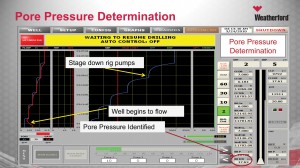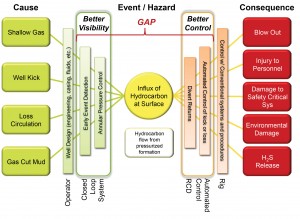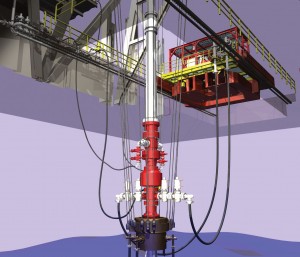MPD powers static pre-drill modeling with dynamic capacity
Continuous data gathering provides more flexible system of well control
By David Pavel and Brian Grayson, Weatherford

Managed pressure drilling (MPD) significantly reduces the likelihood of a well control event and associated wellbore problems by addressing two key challenges associated with conventional methods: the uncertainty of the pre-drill model that is the basis for the well design and the inflexibility of the resulting well design and mud regimes.
Operating with a pressurizable, closed-loop drilling (CLD) system, MPD overcomes both of these challenges by enhancing the ability to perform conventional well control methods, providing a dynamic capacity that is counter to static pre-drill models. The result is a significant advance in the well construction process that enhances well control by minimizing the impact of pressure-related events through real-time detection and mitigation techniques.
Pre-drill modeling
A good well design is based on a geological/geophysical (G&G) model that is predictive in nature, such as pore pressure/fracture gradient (PP/FG) projections and, when available, offset data. But for all the information and considerable expense that goes into this G&G prediction, it is an educated guess that is limited by its static view of how the well will be drilled.
While the intention is to adhere to the plan, once drilling gets under way, the subsurface conditions are invariably different and require changes to the plan. Those deviations might be as simple as adjustments in the mud weight or as drastic as changing casing setting points.
The ability to counter these variations is constrained by a somewhat ridged well design and the inability to easily make changes to the primary well control elements, such as the BOP, drilling fluid design and kick tolerances, that are designed into the well construction plan.
This typically yields a slow response to wellbore events. For example, when a well experiences an influx, information is often limited to the minimal influx pressure based on mud weight and depth. Standard industry procedure is to close the BOP and observe the wellhead pressure in an effort to characterize the nature of the influx. The well is under control, but drilling is stopped.
The next step is to increase mud weight and circulate the kick out of the hole. This is a slow process that can lead to considerable nonproductive time (NPT) and further wellbore complications.
MPD improves on this well control process by continually gathering actual wellbore data to update the pre-drill model and be able to quickly characterize the influx and manage wellbore pressure. This not only provides a flexible system of prevention and mitigation well in advance of conventional well control methods; it also enables the mitigation of difficult pressure-related wellbore problems that result in NPT.
Dynamic modeling
With MPD, the static model becomes dynamic through a continuous process of updating data and modifying wellbore pressures accordingly. Compared with conventional drilling operations, the process provides engineers with more data of higher quality and delivers it in real time at the wellsite.
In the CLD environment, data is acquired from multiple sources while circulating or with pumps off. Temperature, pressure, flow rate and density measurements are used to calculate mass balance across the wellhead so that any loss or gain in the closed system is immediately quantified. In addition, the system also incorporates standpipe and wellhead pressure and downhole measurements such as PWD, MWD and LWD, if available.
These measurements are used to continually update the model in a dynamic process that provides resolution to what is taking place in the well. Thus, MPD reduces the uncertainty surrounding the pre-drill model by providing actual wellbore data and dynamically managing downhole pressures to allow for the drilling operation to stay within narrow drilling windows.
This certainty about what is occurring downhole makes it possible to differentiate between wellbore pressure variations. For example, the ability to quickly distinguish a gas influx from wellbore breathing can be significant. A misdiagnosis can be extremely problematic. Correct diagnosis not only prevents an event from occurring, it avoids missteps that can exacerbate or initiate a greater problem.
MPD control and mitigation

MPD provides a flexible response with control and mitigation barriers that are applied in advance of conventional secondary well control.
Proactive control of annular pressure manages wellbore pressure variations, such as those that occur during transitions from pumps-on and pumps-off, preventing potential kicks or losses during connections than can quickly escalate into a well control event. Monitoring and analyzing data on a continuous basis also provides feedback for updating pore pressure predictions on the fly and for modeling future well designs.
If an influx occurs, the system provides mitigation options ahead of changing mud weight or closing the BOP. Detected immediately at only a fraction of a barrel, the influx is immediately countered with a change in downhole pressure achieved by applying annular backpressure via the MPD automated choke manifold at surface. The influx is stopped while it is very small and safely circulated out of the wellbore.
During this entire process, conventional secondary well control capabilities are fully functional. In addition, crew and rig safety are enhanced by the closed-loop configuration that uses a rotating control device (RCD) above the BOP to divert returns away from the rig floor.
The ability of MPD to control and mitigate downhole pressures enhances and supplements conventional well control procedures. As an added layer of well control, these methods can be applied early, effectively and with much less disruption and cost than traditional means.
MPD enables dynamic leak-off and formation integrity tests (LOTs and FITs) to define the boundaries around PP/FG. This provides engineers with accurate numbers at depth and in real time to define the actual drilling window and navigate it by managing the bottomhole pressure.
Having the actual wellbore PP and FG benefit a variety of applications. For example, in a deepwater well in South America, a dynamic LOT was conducted as part of MPD operations. After successfully drilling the well section, the operator wanted to ensure the best possible cement job. To do that, they wanted to know very precisely the equivalent circulating density threshold. The information acquired in a dynamic LOT allowed them to model the cement job to ensure the desired slurry density and rates could be pumped without losses or formation breakdown.
For riser gas handling in deepwater applications, MPD provides a solution to a difficult safety challenge that is generally outside the capabilities of conventional well control methods. MPD monitoring and control provides a means of identifying and controlling gas breakout in the riser above the BOP.
Riser gas occurs as gas entrained in the return flow breaks out of solution. Industry studies suggest that with oil-based fluids, gas influxes entrained in the return mud flow are unlikely to break out of solution until they rise to a level that is just 2,000 ft to 3,000 ft below the drill floor. At this point, the influx is above the subsea BOP and cannot be mitigated conventionally.
The conventional practice for dealing with gas in the riser is to vent it using the rig diverter system. But this approach provides minimal control and involves considerable risk. In a closed-loop system, the gas is quickly detected as it breaks out, and the application of surface backpressure allows it to be controlled and circulated out of the riser. The RCD adds an additional line of safety in diverting the returns away from the rig floor.
Early kick and loss detection and control are fundamental features of an MPD system. In a closed loop, influxes are rapidly detected and characterized to provide drillers with immediate early detection and control.
Speed of action with an MPD system also benefits more subtle but important aspects of the operation. For example, temperature and time affect mud properties that can complicate issues when fighting a kick over a long period of time. Similar issues can also increase the complexity of cementing operations. Using MPD methods, pressure can be applied to offset density losses due to temperature.
Managing the wellbore
In addition to specific pressure control and mitigation capabilities, MPD also provides the ability to manage the process so that pressure-related problems can be drilled through. In the extremes of total loss circulation, MPD methods enable wells to be drilled that are impossible to drill conventionally. Where unconsolidated formations cause instability that can result in sticking, sidetracking and even abandonment, MPD provides the finely balanced control needed to work in these wellbores.
A good example is the drilling of a well off the coast of Ghana, West Africa. Prior efforts in the deepwater province had encountered major problems with an inherently unstable rubble zone and sharp pore-pressure, fracture-gradients changes.
Drilling in the 12 ¼-in.-hole section returned blocky shale cuttings to the surface, indicating changes in wellbore stability and the mechanical stress regime. A rubble zone was identified as the source of the trouble.
The well packed off several times in the zone as shale sloughed around the bottomhole assembly (BHA). Each time, the BHA was pulled up to a more stable section of the wellbore, but despite the efforts, no drilling progress was made. Eventually the main wellbore was plugged and sidetracked.
A higher mud weight was used to drill the sidetrack in an effort to prevent the sloughing. Using the heavier mud resulted in less instability until a significant drilling break was encountered.
Although there had been no indication of high pressure in prior drilling, the well took a 16- to 20-bbl influx. The influx led to shutting in the well, which resulted in the hole packing off again and the BHA becoming stuck. The problems could not be overcome, and ultimately the well was permanently plugged and abandoned.
MPD problem mitigation

The next Ghana offset was drilled using an MPD system, which enabled the well to reach the planned depth without borehole stability issues, underreaming or contingency liners.
Accurate detection and control of small influxes in the Ghana well provided the wellbore stability necessary to drill through the trouble zone and reach the planned depth. Annular backpressure maintained stability in the rubble zone by managing ballooning while making connections and by avoiding swabbing when pulling out of the hole. While these conditions are difficult to assess in conventional drilling operations, they are easily identified and mitigated with MPD methods.
The system was instrumental in identifying and controlling small influxes and losses while drilling the 12 ¼-in. and 8 ½-in. sections of the well. Real-time monitoring and control mitigated small oscillations in wellbore pressure before they could escalate into a well control event and provided the means to safely circulate the gas out of the well while drilling.
At the same time, MPD provided a first line of well control ahead of conventional BOP and mud weight management methods. The additional layer of well control mitigated a major source of drilling risk and associated NPT. It also provided the ability to mitigate riser gas on the semisubmersible rig.
MPD well control
Kick simulations were performed to identify the limits of drilling equipment used on the West Africa well, including pressure loadings on the casing shoe, choke line, RCD, riser and BOP. These are key elements of MPD well control, and it is important to ensure that pressure can be safely circulated through them and out of the well through the MPD choke.
Preparations for the project involved transient simulations using the kick module of Dynamic Well Control software. While typically used to simulate different kick situations for conventional drilling, assumptions were made that allowed the software to be used with an MPD system.
A well control matrix was developed to describe a clear course of action based on surface pressure and the volume of the influx. The matrix supports decision-making during critical operations to achieve a rapid well control response. The matrix developed for the West Africa well categorizes the different severities of influx and assigns respective operational procedures to address each possible scenario.
Three operating limits were defined. The normal state has no influx and exhibits surface backpressure of less than 150 psi. In this category, operations may continue without any other action. The second limit is defined by an influx size up to 5 bbl with a surface backpressure limit of less than 800 psi. In this state, drilling stops while the influx is circulated out of the hole. The third limit is reached with an influx greater than 5 bbl and backpressure of more than 800 psi. At this point, drilling operations are suspended and the well shut in using the subsea BOP.
A high degree of planning and organization was important to the successful drilling of the Ghana well. An MPD well control strategy precisely defined and documented the procedure for monitoring and circulating gas out of the well, including riser gas, and a decision tree was developed to identify the severity of influx and the correct operational procedures.
Advanced well construction
MPD provides a significant advance in the well construction process that enhances the flexibility and effectiveness of well control, while reducing pressure-related wellbore problems. Instead of coping with a pre-drill well model that is static by nature, drillers are provided with a dynamic tool for understanding wellbore pressure in much greater resolution, controlling it with greater efficiency and effectiveness, and adding management capabilities so precise that pressure-related problems are mitigated.
Microflux is a trademark of Weatherford.




